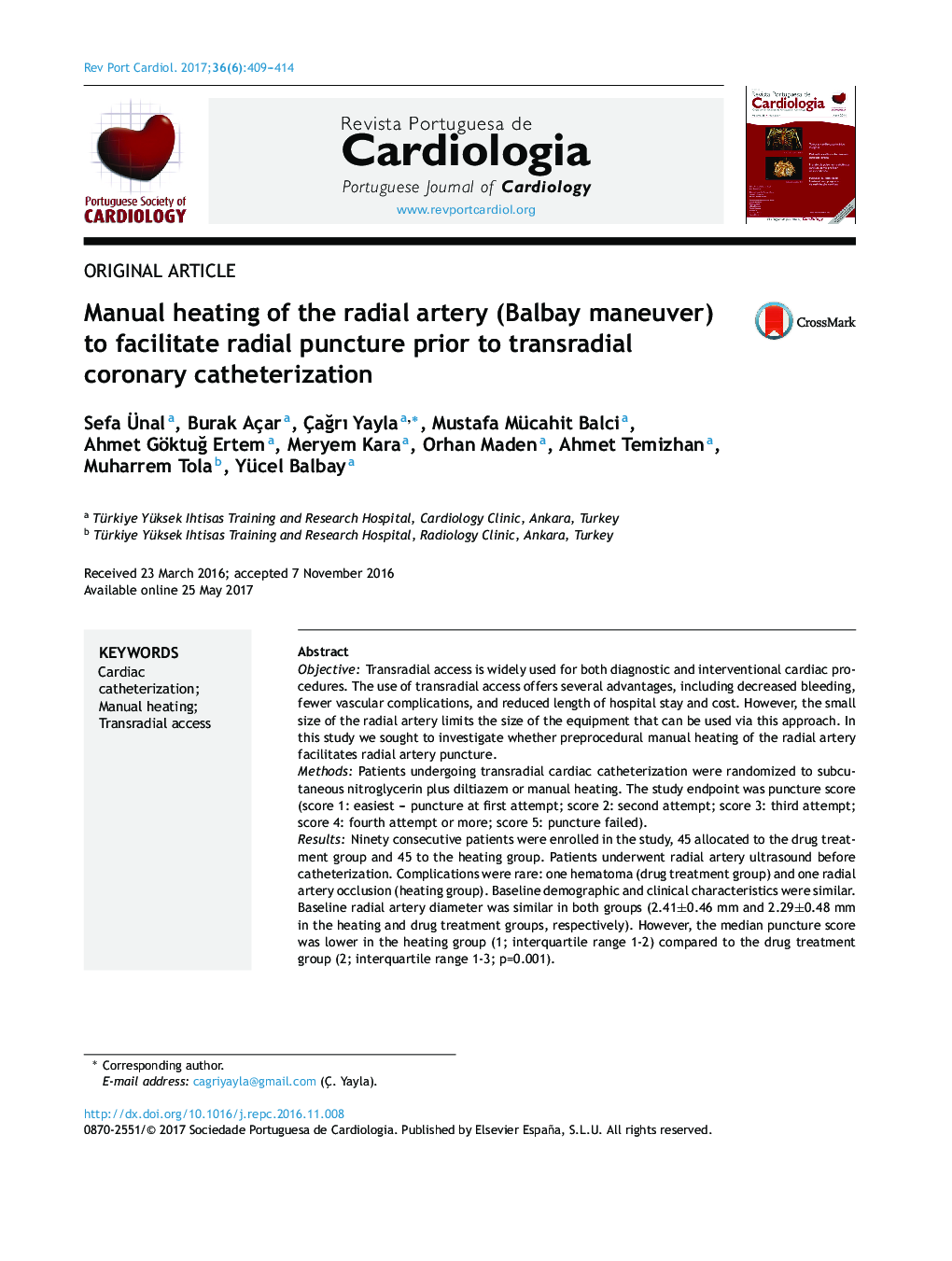| Article ID | Journal | Published Year | Pages | File Type |
|---|---|---|---|---|
| 5126397 | Revista Portuguesa de Cardiologia | 2017 | 6 Pages |
ObjectiveTransradial access is widely used for both diagnostic and interventional cardiac procedures. The use of transradial access offers several advantages, including decreased bleeding, fewer vascular complications, and reduced length of hospital stay and cost. However, the small size of the radial artery limits the size of the equipment that can be used via this approach. In this study we sought to investigate whether preprocedural manual heating of the radial artery facilitates radial artery puncture.MethodsPatients undergoing transradial cardiac catheterization were randomized to subcutaneous nitroglycerin plus diltiazem or manual heating. The study endpoint was puncture score (score 1: easiest - puncture at first attempt; score 2: second attempt; score 3: third attempt; score 4: fourth attempt or more; score 5: puncture failed).ResultsNinety consecutive patients were enrolled in the study, 45 allocated to the drug treatment group and 45 to the heating group. Patients underwent radial artery ultrasound before catheterization. Complications were rare: one hematoma (drug treatment group) and one radial artery occlusion (heating group). Baseline demographic and clinical characteristics were similar. Baseline radial artery diameter was similar in both groups (2.41±0.46 mm and 2.29±0.48 mm in the heating and drug treatment groups, respectively). However, the median puncture score was lower in the heating group (1; interquartile range 1-2) compared to the drug treatment group (2; interquartile range 1-3; p=0.001).ConclusionsPreprocedural manual heating of the radial artery facilitates radial artery puncture in patients undergoing transradial cardiac catheterization.
ResumoObjetivoO acesso transradial (ATR) é usado habitualmente quer para procedimentos diagnósticos quer de intervenção coronária. O uso de ATR oferece várias vantagens: redução das hemorragias, menos complicações vasculares, menor tempo de internamento e representa menos custos associados. Porém, o reduzido calibre da artéria radial limita o tamanho dos dispositivos que podem ser usados por este acesso. Neste estudo, investigamos se o prévio aquecimento da artéria radial facilita, ou não, a punção radial.MétodosDoentes submetidos a cateterismo cardÃaco por ATR foram aleatorizados para uma administração subcutânea de uma combinação de nitroglicerina e diltiazem ou, em alternativa, aquecimento manual da artéria radial. O endpoint do estudo foi o score de punção (score 1: punção simples à primeira tentativa; score 2: punção à segunda tentativa; score 3: punção à terceira tentativa; score 4: punção à quarta ou mais tentativa; score 5: punção radial falhada).ResultadosNoventa doentes consecutivos foram incluÃdos no estudo - 45 no grupo de tratamento farmacológico e 45 no grupo de aquecimento manual. Os doentes fizeram avaliação ecográfica da artéria radial antes do cateterismo. As complicações ocorreram de forma rara: um hematoma (grupo tratamento) e uma oclusão radial (grupo aquecimento). As caraterÃsticas basais demográficas e clÃnicas foram semelhantes. O diâmetro basal da artéria radial foi semelhante em ambos os grupos (2,41 ± 0,46 mm e 2,29 ± 0,48 mm nos grupos de aquecimento e de tratamento, respetivamente). No entanto, o score de punção foi mais baixo no grupo aquecimento (1; intervalo interquartil 1-2) comparado com o grupo tratamento (2; intervalo interquartil 1-3; p=0,001).ConclusõesO aquecimento manual da artéria radial facilita a punção radial em doentes submetidos a cateterismo cardÃaco por via transradial.
